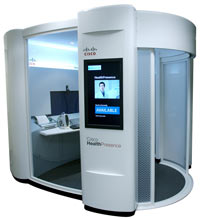 |
Patients in Scotland will be able to get treatments in specialised health booths, as part of a new collaboration between Cisco and the Scottish Centre for Telehealth.
The new HealthPresence solution will be piloted in all of the Scottish health boards, though exact locations are still to be decided. The solution involves specialised booths equipped with video conferencing facilities enabling a face-to-face referral from a remote doctor.
Speaking to E-Health Insider at the Telco 2.0 3rd Executive Brainstorm in London, Cisco’s healthcare director for internet business solutions, Nicholas Augustinos, said: “With HealthPresence patients will be able to seek medical advice from anywhere; booths can be fitted anywhere from shopping malls to hotels to post offices. Ultimately, we’d like to see it packaged up and brought into the home.
“This self service healthcare stand concept is a truly unique vision for the future which will bring video conferencing into the mainstream.”
The booths will be fitted by the Scottish Centre for Telehealth and they will be active by December.
Inside, patients will find a range of medical devices, including blood pressure cuffs, glucose monitors, audioscopes and stethoscopes, that upload data directly into an electronic medical record with high-definition video conferencing technology.
Patients can sit in front of a monitor with a webcam and communicate with a doctor via the video-teleconferencing technology.
Augustinos said: “We are going to pilot this in Scotland to extend healthcare delivery using a new form of visible technology to provide the best clinical help possible using such connectivity. We will use a series of medical devices able to provide the doctor at the other end with the best possible clinical data to make the most effective diagnosis possible.”
Outside the booth, an electronic screen will display generic medical information, as well as a sign to indicate if the booth is vacant.
The Scottish Centre for Telehealth says that plans are still being finalised, but they want ‘to investigate how technology can be used to facilitate new ways of working to address the increasing pressures on healthcare services as a result of an aging population and workforce and fiscal constraints.’
Cisco says the solution extends the reach of healthcare across many points, something the company aims to develop in the future.
“Typically healthcare systems are confined to locations – patients and clinicians see each other at one place. The idea is to create many access points and still offer the same healthcare service. Video conferencing allows you to feel that a doctor is sitting across from you. You can look them in the eyes, and they can look at you in the eyes,” said Augustinos.
He added it was similar to ‘marrying the patient and the doctor’ to ‘create many-to-many points for one end point technological advance’ which would ultimately ‘address the imbalance of supply and demand.’
The Scottish Centre for Telehealth lists the objectives of the pilot as:
- develop and test the clinical engagement processes for the HealthPresence (clinicians & patient)
- determine and test the added value of ‘HealthPresence’ versus current clinical engagements / operating costs
- determine and test the operational process of the booth (safety, security, cleanliness, availability, accessibility)
- develop, test and demonstrate the technical systems and information management systems – including reliability, security, service management, capacity and performance
Links
The Scottish Centre for Telehealth
Joe Fernandez
